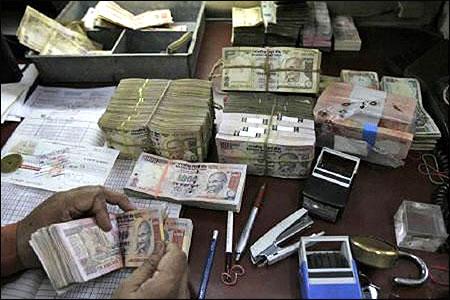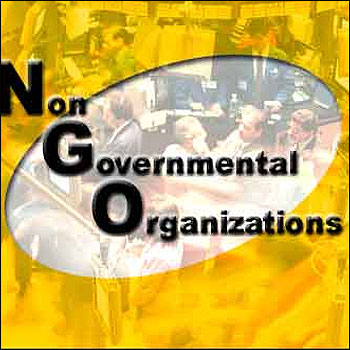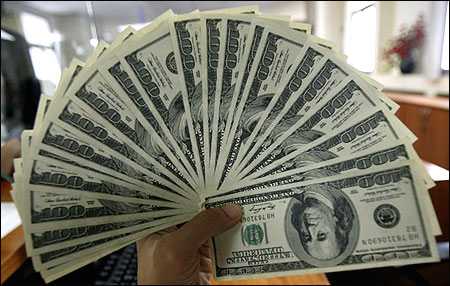Last updated on: February 29, 2012 15:22 IST
Sanjeev Nayyar
It is time the government woke up to the risks that uncontrolled foreign monies flowing to Indian NGOs pose to India's economic progress, social cohesion and national integrity.

PM wakes up to dollar driven NGO threat, screamed a newspaper headline. The government has cancelled licenses of three such organisations for diversion of funds to fuel anti-nuclear protests in India.
This decision has once again put the spotlight on foreign funding of NGOs. A close perusal of the FCRA Report published by the home ministry reveals billions of dollars received by NGOs in India.
Before analysing the latest FCRA report a bit about the regulatory framework for NGOs to receive foreign money.
The Foreign Contribution Regulation Act was passed in 1976. It was repealed and FCRA 2010 was passed along with the Foreign Contribution Regulation Rules 2011. Both became effective from May 1 2011.
They seek to regulate the receipt of funds by NGOs. The FCRA is managed by the Ministry of Home Affairs (MHA).
Any organisation that wants to receive contributions from abroad has to apply and get approval from the home ministry. All remittances are received into a single bank account of a scheduled bank or through such branches as may be specified.
If an NGO, whether registered or not, receives a contribution in excess of Rs 1 cr (rs 10 million) during a period of 30 days, the bank has to report this to the central government within 30 days of the date of such last transaction.
The NGO has to annually submit audited receipts, payments account, balance sheet etc to the ministry. The MHA scrutinises the returns to ensure that contributions received for a particular purpose are used for that purpose only. It does a detailed check of randomly picked associations and collates the data received to present the FCRA Annual Report [uploaded on http://mha.nic.in/fcra.htm]
The associations could be religious, social, educational, cultural or educational organisations. MHA wants to ensure that foreign contributions are utilized for bona fide activities and do not compromise national security.
The FCRA report for the year ended 31st March 2010 was published on 11th January 2012 i.e. 21 months after year end.

PM wakes up to dollar driven NGO threat, screamed a newspaper headline. The government has cancelled licenses of three such organisations for diversion of funds to fuel anti-nuclear protests in India.
This decision has once again put the spotlight on foreign funding of NGOs. A close perusal of the FCRA Report published by the home ministry reveals billions of dollars received by NGOs in India.
Before analysing the latest FCRA report a bit about the regulatory framework for NGOs to receive foreign money.
The Foreign Contribution Regulation Act was passed in 1976. It was repealed and FCRA 2010 was passed along with the Foreign Contribution Regulation Rules 2011. Both became effective from May 1 2011.
They seek to regulate the receipt of funds by NGOs. The FCRA is managed by the Ministry of Home Affairs (MHA).
Any organisation that wants to receive contributions from abroad has to apply and get approval from the home ministry. All remittances are received into a single bank account of a scheduled bank or through such branches as may be specified.
If an NGO, whether registered or not, receives a contribution in excess of Rs 1 cr (rs 10 million) during a period of 30 days, the bank has to report this to the central government within 30 days of the date of such last transaction.
The NGO has to annually submit audited receipts, payments account, balance sheet etc to the ministry. The MHA scrutinises the returns to ensure that contributions received for a particular purpose are used for that purpose only. It does a detailed check of randomly picked associations and collates the data received to present the FCRA Annual Report [uploaded on http://mha.nic.in/fcra.htm]
The associations could be religious, social, educational, cultural or educational organisations. MHA wants to ensure that foreign contributions are utilized for bona fide activities and do not compromise national security.
The FCRA report for the year ended 31st March 2010 was published on 11th January 2012 i.e. 21 months after year end.

Trends in foreign contributions
Indian NGOs received a staggering Rs 94,520 cr (Rs 945.20 billion) from 1993-94 to 2009-10.
As on 31.3.2010, there were 38,436 registered associations, up 5.5 per cent from the previous year, 27 per cent when compared to 2004-05 and 68 per cent as compared to 2000-01. Clearly the number of registered NGOs that receive dollars has seen a huge surge in the last decade.
Year | Registered Associations (as on 31st March of F.Y.) | Associations that gave details of remittances received | Amounts received Rs crs |
1993-94 | 15,039 | Not Available | 1865 |
2000-01 | 22,924 | 64% | 4535 |
2003-04 | 28,351 | 61% | 5105 |
2004-05 | 30,321 | 61% | 6257 |
2005-06 | 32,144 | 58% | 7878 |
2006-07 | 33,937 | 56% | 11,336 |
2007-08 | 34,803 | 54% | 9,663 |
2008-09 | 36,414 | 55% | 10,803 |
2009-10 | 38,436 | 56% | 10,338 |
Total 1993-94 to 2009-10 | 94,520 | ||
$ Billion | 18.90 |
All numbers in this article are reproduced from FCRA reports published by the MHA. Assumed an exchange rate of Rs 50 to a dollar and all figures rounded off to the nearest crore in article.
In 2009-10, 7,275 of the 21,508 associations who submitted their accounts did not receive any foreign contributions. This means that only 46 per cent of the associations who received foreign contributions filed their annual returns with MHA.Hence, the actual amount of contributions received by NGOs would be much higher than Rs 10,338 cr (Rs 103.38 billion) reported above.
Is such unreported contribution being used for money laundering, terrorist activities or funding protests as mentioned by Prime Minister Singh?
During the year, 21,000 defaulter associations which had not submitted returns for the years 2006-07, 2007-08, 2008-09 were issued Show Cause Notices. We are already in the first quarter of 2012.
By the time these NGOs reply to the notices and the government decides what action to take against them, the NGOs might receive many more crore with zero accountability to the government.

Largest donors country wise (in Rs cr)
Year | USA | Germany | UK | Italy others |
2002-03 | 1680 | 715 | 685 | NA |
2003-04 | 1584 | 757 | 676 | 350 |
2004-05 | 1927 | 931 | 764 | 353# |
2005-06 | 2426 | 1181 | 1062 | 500 |
2006-07 | 2949 | 1033 | 1428 | 606& |
2007-08 | 2928 | 971 | 1269 | 515 |
2008-09 | 3433 | 1103 | 1131 | 547 |
2009-10 | 3106 | 1046 | 1039 | 583 |
Total | 20,033 | 7,737 | 8,054 | 3,454 |
$ Billion | 4.0 | 1.55 | 1.61 |
Italy, #Netherlands, & Switzerland.
The top three donor countries for many years have been USA, Germany, and UK. Remittances from the U.S. between 2002-03 and 2009-10 have nearly doubled. Despite the economic downturn, the West has continued contributions to Indian NGOs? Why?
The top three donor countries for many years have been USA, Germany, and UK. Remittances from the U.S. between 2002-03 and 2009-10 have nearly doubled. Despite the economic downturn, the West has continued contributions to Indian NGOs? Why?

Key Donors: Country wise Trends (in Rs cr)
Country | 2009-10 | Country | 2008-9 | Country | 2007-8 |
USA | 3106 | USA | 3433 | USA | 2928 |
Germany | 1046 | UK | 1131 | UK | 1269 |
UK | 1039 | Germany | 1103 | Germany | 971 |
Italy | 583 | Italy | 547 | Italy | 515 |
Netherlands | 509 | Netherlands | 513 | Netherlands | 414 |
Spain | 437 | Spain | 437 | Spain | 401 |
Switzerland | 302 | Switzerland | 370 | Switzerland | 364 |
Canada | 298 | Canada | 303 | Canada | 276 |
France | 189 | France | 193 | France | 196 |
Australia | 148 | Australia | 131 | Australia | 138 |
UAE | 133 | Belgium | 124 | Belgium | 100 |
Belgium | 122 | Austria | 106 | Austria | 99 |
Austria | 112 | Sweden | 103 | Sweden | 89 |
Sweden | 106 | UAE | 146 | UAE | 79 |
Mauritius | 101 | Ireland | 69 | Ireland | 77 |
Should a country that aspires to be a superpower continue to receive billions of dollars as charity every year? Spain and Italy are in dire economic straits, Britain had a fiscal deficit of 11% of GDP in 2009-10 yet they remitted over Rs 1000 crs to Indian NGOs per annum.
Significantly, barring the UAE, all countries listed above belong to the West. Media reports indicate that some countries in the Middle East, notably Saudi Arabia, made large remittances to India, but these contributions are not listed officially. They are either not coming, or are coming through the hawala route.

Largest donors: Agency wise trends (in Rs cr)
Donor Name & Country | 2009-10 | Donor Name & Country | 2008-09 |
Gospel For Asia Inc USA | 233 | World Vision International USA | 706 |
Fundacion Vicente Ferrer, Barcelona, Spain | 229 | Gospel For Asia Inc USA | 596 |
World Vision Global Centre, USA | 198 | Fundacion Vicente Ferrer, Barcelona, Spain | 458 |
Compassion International, USA | 132 | Shyam Shyam Dham Samiti India | 359 |
HCL Holdings Pvt Ltd, Mauritius | 94 | Compassion International, USA | 347 |
Om Foundaiton, USA | 64 | Fundacion Vicente Ferrer, Spain | 241 |
Population Service International, USA | 51 | Action Aid International, UK | 228 |
Oxfam GB, UK | 45 | BAPS, Inc USA | 199 |
Save The Children, UK | 44 | Christian Children Fund, USA | 197 |

No comments:
Post a Comment